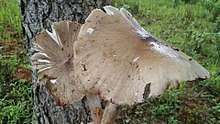Macrolepiota albuminosa
Macrolepiota albuminosa, or termite mushroom, is a species of agaric fungus in the family Agaricaceae that is an obligate symbiont of termites. First described scientifically as Agaricus albuminosus by Miles Joseph Berkeley in 1847, it was transferred to the genus Macrolepiota by David Pegler in 1972.[3] The fruit bodies (mushrooms) of the fungus are edible.[4] It is found growing from termitaria in grassy fields, hills, and or forest borders in China [5] and Vietnam.
| Macrolepiota albuminosa | |
|---|---|
 | |
| Scientific classification | |
| Kingdom: | |
| Division: | |
| Class: | |
| Order: | |
| Family: | |
| Genus: | |
| Species: | M. albuminosa |
| Binomial name | |
| Macrolepiota albuminosa | |
| Synonyms[1] | |
| |
References
- "Macrolepiota albuminosa (Berk.) Pegler, Kew Bull. 27(1): 189 (1972)". Index Fungorum. CAB International. Retrieved 2012-12-20.
- Heim R. (1941). "Études descriptives et expérimentales sur les agarics termitophiles d'Afriquetropicale". Mémoires de l'Académie des Sciences de l'Institut de France (in French). 64: 1–74.
- Pegler D. (1972). "A revision of the genus Lepiota from Ceylon". Kew Bulletin. 27 (1): 155–202 (see p. 189). doi:10.2307/4117880. JSTOR 4117880.
- Boa E. (2004). Wild Edible Fungi: A Global Overview of Their Use and Importance to People (Non-Wood Forest Products). Food & Agriculture Organization of the UN. p. 115. ISBN 92-5-105157-7.
- Hu S-Y. (2005). Food Plants of China. Chinese University Press. p. 267. ISBN 978-962-996-229-6.
This article is issued from Wikipedia. The text is licensed under Creative Commons - Attribution - Sharealike. Additional terms may apply for the media files.